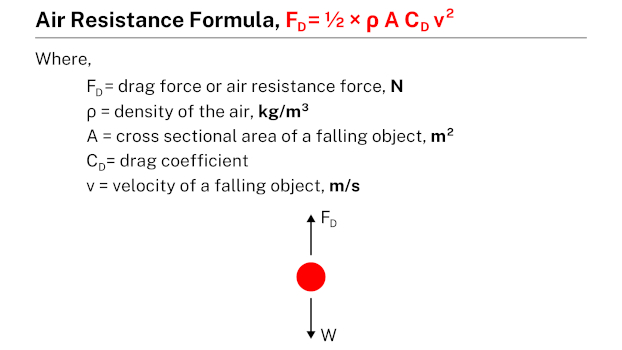Update: This page’s content is moving to a new address in the upcoming months.

Air resistance formula, also known as the drag force formula, calculates the force experienced by an object moving through a fluid medium, such as air. It is represented by the equation FD = ½ × ρ A CD v2, where FD is the drag force, ρ is the density of the fluid, A is the cross-sectional area of the object, CD is the drag coefficient, and v is the velocity of the object.
Practice problems
Problem #1
Calculate the air resistance force acting on a feather that is falling with a velocity of 8 m/s. Given the density of the air as 1.20 kg/m3, the cross-sectional area of the feather as 0.02 m2, and the drag coefficient as 0.05.
Solution
Given data:
- Air resistance force acting on a feather, FD = ?
- Velocity of a feather, v = 8 m/s
- Density of the air, ρ = 1.20 kg/m3
- Cross sectional area of a feather, A = 0.02 m2
- Drag coefficient, CD = 0.05
Applying the formula:
- FD = ½ × ρ A CD v2
- FD = ½ × 1.20 × 0.02 × 0.05 × (8)2
- FD = 0.03 N
Therefore, the air resistance force acting on a feather is 0.03 N.
Problem #2
When a skydiver jumps from a plane, the skydiver falls with a velocity of 45 m/s. Determine the air resistance force acting on the skydiver, considering the density of the air as 1.25 kg/m3, the cross-sectional area of the skydiver as 0.20 m2, and the drag coefficient as 0.70.
Solution
Given data:
- Velocity of a skydiver, v = 45 m/s
- Air resistance force acting on a skydiver, FD = ?
- Density of the air, ρ = 1.25 kg/m3
- Cross sectional area of a skydiver, A = 0.20 m2
- Drag coefficient, CD = 0.70
Applying the formula:
- FD = ½ × ρ A CD v2
- FD = ½ × 1.25 × 0.20 × 0.70 × (45)2
- FD = 177.18 N
Therefore, the air resistance force acting on a skydiver is 177.18 N.
Problem #3
A leaf is descending from a certain height with a velocity of 10 m/s while floating in the air. Find the air resistance force acting on the leaf, taking into account the density of the air as 1.22 kg/m3, the cross-sectional area of the leaf as 0.05 m2, and the drag coefficient as 0.08.
Solution
Given data:
- Velocity of a leaf, v = 10 m/s
- Air resistance force acting on a leaf, FD = ?
- Density of the air, ρ = 1.22 kg/m3
- Cross sectional area of a leaf, A = 0.05 m2
- Drag coefficient, CD = 0.08
Applying the formula:
- FD = ½ × ρ A CD v2
- FD = ½ × 1.22 × 0.05 × 0.08 × (10)2
- FD = 0.24 N
Therefore, the air resistance force acting on a leaf is 0.13 N.
Problem #4
Find the value of the air resistance force acting on a parachute bag that is falling with a velocity of 30 m/s after being thrown from a helicopter. Given the density of the air as 1.21 kg/m3, the cross-sectional area of the parachute bag as 0.10 m2, and the drag coefficient as 0.12.
Solution
Given data:
- Air resistance force acting on a parachute bag, FD = ?
- Velocity of a parachute bag, v = 30 m/s
- Density of the air, ρ = 1.21 kg/m3
- Cross sectional area of a parachute bag, A = 0.10 m2
- Drag coefficient, CD = 0.12
Applying the formula:
- FD = ½ × ρ A CD v2
- FD = ½ × 1.21 × 0.10 × 0.12 × (30)2
- FD = 6.53 N
Therefore, the air resistance force acting on a parachute bag is 6.53 N.
Related
More topics
- Free fall equation
- Air resistance formula
- Terminal velocity equation
- Gravity equation
- Inertia formula
- Acceleration formula
- Momentum equation
- Mass formula
- Velocity formula
- Pressure equation
- Kinematic equations
- Friction equation
External links
- Falling Object with Air Resistance – NASA (.gov)
- Free Fall and Air Resistance – The Physics Classroom
- Free Fall with Air Resistance Calculator – Omni Calculator
- Drag (physics) – Wikipedia
- Air Resistance | Definition, Examples & Calculation – Study.com
- Air Resistance Formula – SoftSchools.com
- Finding the drag force (Air resistance force) for accelerated ball? – Physics Stack Exchange
- How do you calculate the force of air resistance? – How Things Fly
- Drag Forces | Physics – Lumen Learning
- 7.3: Air Resistance Proportional to the Square of the Speed – Physics LibreTexts
- Air and fluid resistance (article) | Forces – Khan Academy
- How do I calculate projectile trajectory with air resistance? – Reddit
- Air Friction – HyperPhysics Concepts
- Projectiles with air resistance – University of Illinois Urbana-Champaign
- Air Resistance Calculator – EngineerExcel
- Free Fall with Air Resistance Calculator – CalcTool
- Section 15 – Freefall with Air Resistance – California State University, Chico
- Air Resistance: Definition, Formula & Example – Vaia
- Intro to air resistance – University of Colorado Boulder
- How do you calculate air resistance for a freely falling body? – Quora
- How to Calculate Air Resistance – Science Struck
Deep
Learnool.com was founded by Deep Rana, who is a mechanical engineer by profession and a blogger by passion. He has a good conceptual knowledge on different educational topics and he provides the same on this website. He loves to learn something new everyday and believes that the best utilization of free time is developing a new skill.
